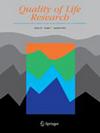Development of the celiac disease symptom diary version 2.1© (CDSD 2.1© ) patient-reported outcome measure.
Kellee Howard, Daniel Adelman, Sonal Ghura, Sarah Acaster, Sarah Clifford, Ciaran P Kelly, Susan A Martin, Lisa M Meckley, Daniel A Leffler
下载PDF
{"title":"Development of the celiac disease symptom diary version 2.1<sup>©</sup> (CDSD 2.1<sup>©</sup>) patient-reported outcome measure.","authors":"Kellee Howard, Daniel Adelman, Sonal Ghura, Sarah Acaster, Sarah Clifford, Ciaran P Kelly, Susan A Martin, Lisa M Meckley, Daniel A Leffler","doi":"10.1007/s11136-024-03799-6","DOIUrl":null,"url":null,"abstract":"<p><strong>Purpose: </strong>For patients with celiac disease (CeD), the only current management option is adherence to a strict gluten-free diet (GFD); however, many patients on a GFD continue to experience symptoms with a significant impact on quality of life. Potential new treatments for CeD are under development and a validated patient-reported outcome measure is required to evaluate their utility in clinical trials. The purpose of this article is to provide a history of the development of the Celiac Disease Symptom Diary (CDSD) 2.1<sup>©</sup> for use in clinical trials.</p><p><strong>Methods: </strong>Qualitative and quantitative studies were conducted from 2010 to 2021, including concept elicitation and cognitive debriefing interviews with adult and adolescent participants with CeD (N = 93) diagnosed via biopsy and/or serology and input from eight interviews with CeD clinical experts. During these studies, different iterations of the CDSD were presented to the US Food and Drug Administration and the European Medicines Agency, and modifications were made in line with their feedback.</p><p><strong>Results: </strong>These studies ultimately led to the development of CDSD 2.1<sup>©</sup>, a daily diary which focuses on key symptoms of CeD (abdominal pain, bloating, diarrhea, nausea and tiredness). This patient-reported outcome measure was readily understood by adult and adolescent participants with CeD and content validity was demonstrated in both populations.</p><p><strong>Conclusion: </strong>CDSD 2.1<sup>©</sup> is a content-valid patient-reported outcome measure developed in accordance with best practices and regulatory guidance. A thorough exploration of the psychometric properties of CDSD 2.1<sup>©</sup> for both adult and adolescent participants with CeD is ongoing to support utilization in clinical trials.</p>","PeriodicalId":20748,"journal":{"name":"Quality of Life Research","volume":" ","pages":"3275-3282"},"PeriodicalIF":3.3000,"publicationDate":"2024-12-01","publicationTypes":"Journal Article","fieldsOfStudy":null,"isOpenAccess":false,"openAccessPdf":"https://www.ncbi.nlm.nih.gov/pmc/articles/PMC11599373/pdf/","citationCount":"0","resultStr":null,"platform":"Semanticscholar","paperid":null,"PeriodicalName":"Quality of Life Research","FirstCategoryId":"3","ListUrlMain":"https://doi.org/10.1007/s11136-024-03799-6","RegionNum":3,"RegionCategory":"医学","ArticlePicture":[],"TitleCN":null,"AbstractTextCN":null,"PMCID":null,"EPubDate":"2024/10/26 0:00:00","PubModel":"Epub","JCR":"Q1","JCRName":"HEALTH CARE SCIENCES & SERVICES","Score":null,"Total":0}
引用次数: 0
引用
批量引用
Abstract
Purpose: For patients with celiac disease (CeD), the only current management option is adherence to a strict gluten-free diet (GFD); however, many patients on a GFD continue to experience symptoms with a significant impact on quality of life. Potential new treatments for CeD are under development and a validated patient-reported outcome measure is required to evaluate their utility in clinical trials. The purpose of this article is to provide a history of the development of the Celiac Disease Symptom Diary (CDSD) 2.1© for use in clinical trials.
Methods: Qualitative and quantitative studies were conducted from 2010 to 2021, including concept elicitation and cognitive debriefing interviews with adult and adolescent participants with CeD (N = 93) diagnosed via biopsy and/or serology and input from eight interviews with CeD clinical experts. During these studies, different iterations of the CDSD were presented to the US Food and Drug Administration and the European Medicines Agency, and modifications were made in line with their feedback.
Results: These studies ultimately led to the development of CDSD 2.1© , a daily diary which focuses on key symptoms of CeD (abdominal pain, bloating, diarrhea, nausea and tiredness). This patient-reported outcome measure was readily understood by adult and adolescent participants with CeD and content validity was demonstrated in both populations.
Conclusion: CDSD 2.1© is a content-valid patient-reported outcome measure developed in accordance with best practices and regulatory guidance. A thorough exploration of the psychometric properties of CDSD 2.1© for both adult and adolescent participants with CeD is ongoing to support utilization in clinical trials.
开发腹腔疾病症状日记 2.1©(CDSD 2.1©)患者报告结果测量方法。
目的:对于乳糜泻(CeD)患者来说,目前唯一的治疗方法是坚持严格的无麸质饮食(GFD);然而,许多患者在坚持无麸质饮食后仍会出现症状,严重影响生活质量。潜在的 CeD 新疗法正在开发中,需要一种经过验证的患者报告结果测量方法来评估其在临床试验中的效用。本文旨在介绍用于临床试验的乳糜泻症状日记(CSD)2.1© 的开发历史:方法:2010年至2021年期间进行了定性和定量研究,包括对通过活检和/或血清学确诊患有乳糜泻的成人和青少年参与者(N = 93)进行概念诱导和认知汇报访谈,以及对8名乳糜泻临床专家进行访谈。在这些研究过程中,我们向美国食品药品管理局和欧洲药品管理局提交了 CDSD 的不同迭代版本,并根据他们的反馈意见进行了修改:这些研究最终促成了 CDSD 2.1©的开发,它是一种侧重于 CeD 主要症状(腹痛、腹胀、腹泻、恶心和疲倦)的每日日记。成人和青少年 CeD 参与者很容易理解这种由患者报告的结果测量方法,而且这两种人群都证明了其内容的有效性:CDSD 2.1©是根据最佳实践和法规指南开发的一种内容效度良好的患者报告结果测量方法。目前正在对 CDSD 2.1©针对成人和青少年 CeD 参与者的心理测量特性进行深入探讨,以支持在临床试验中的应用。
本文章由计算机程序翻译,如有差异,请以英文原文为准。


